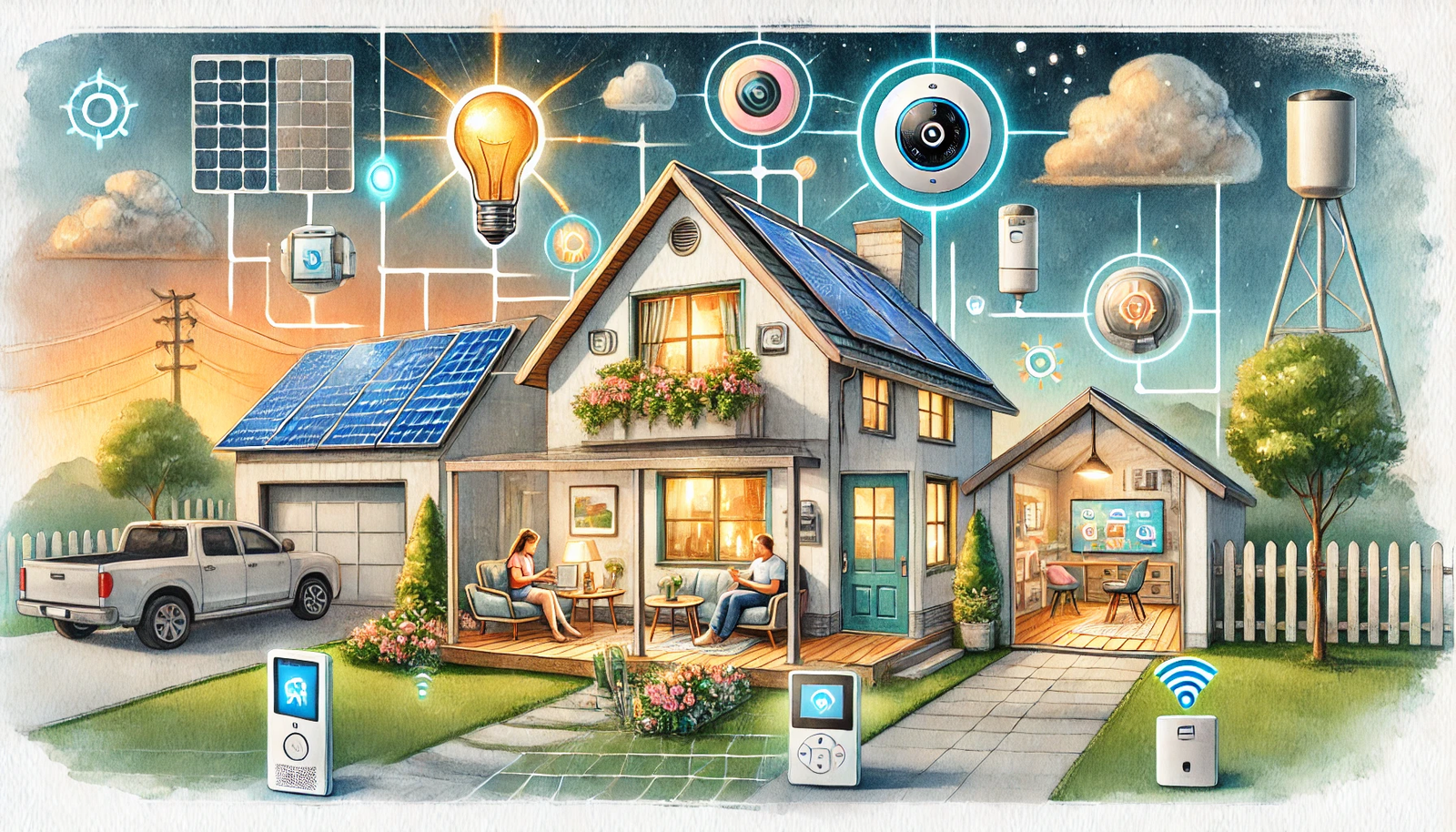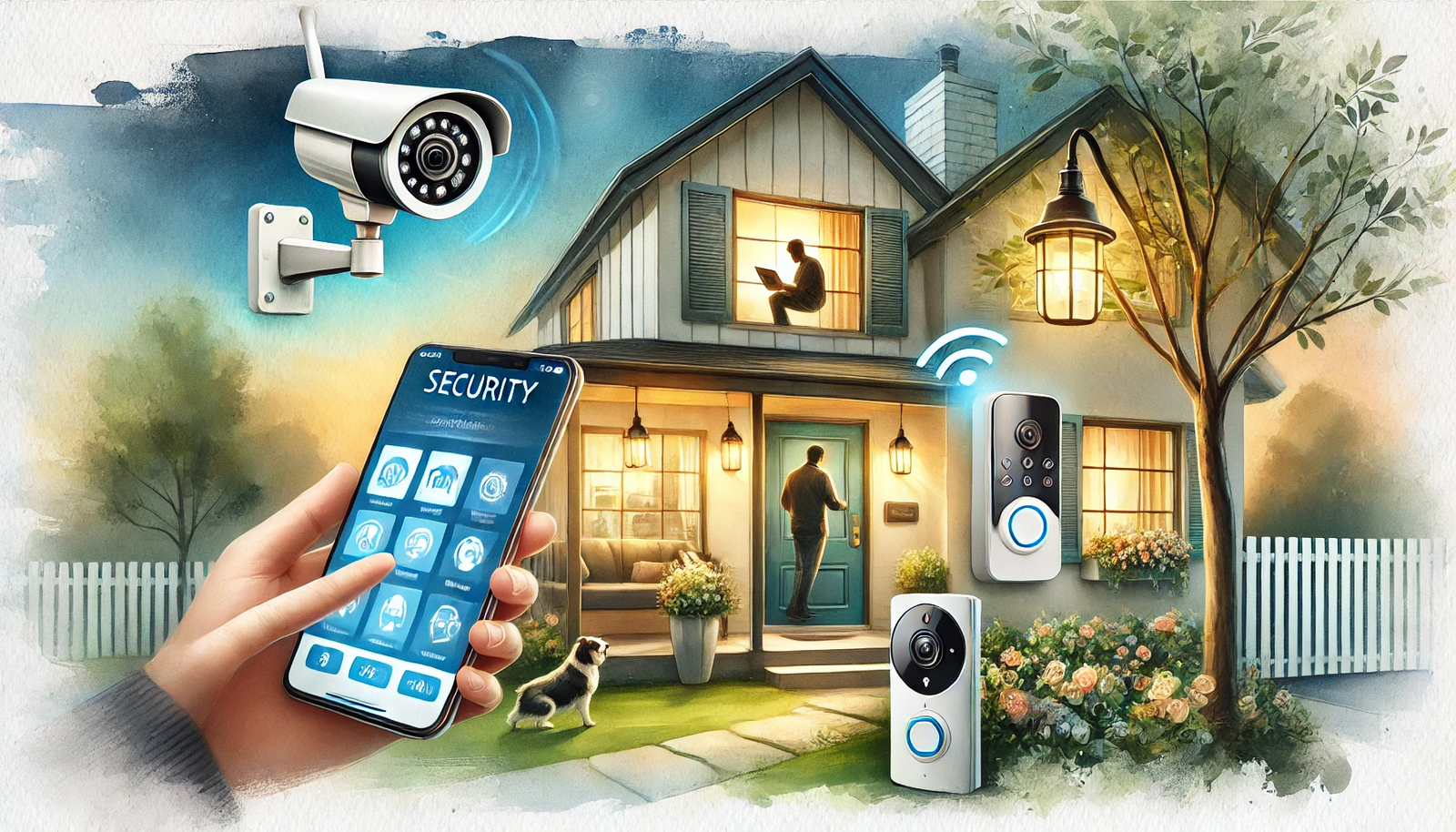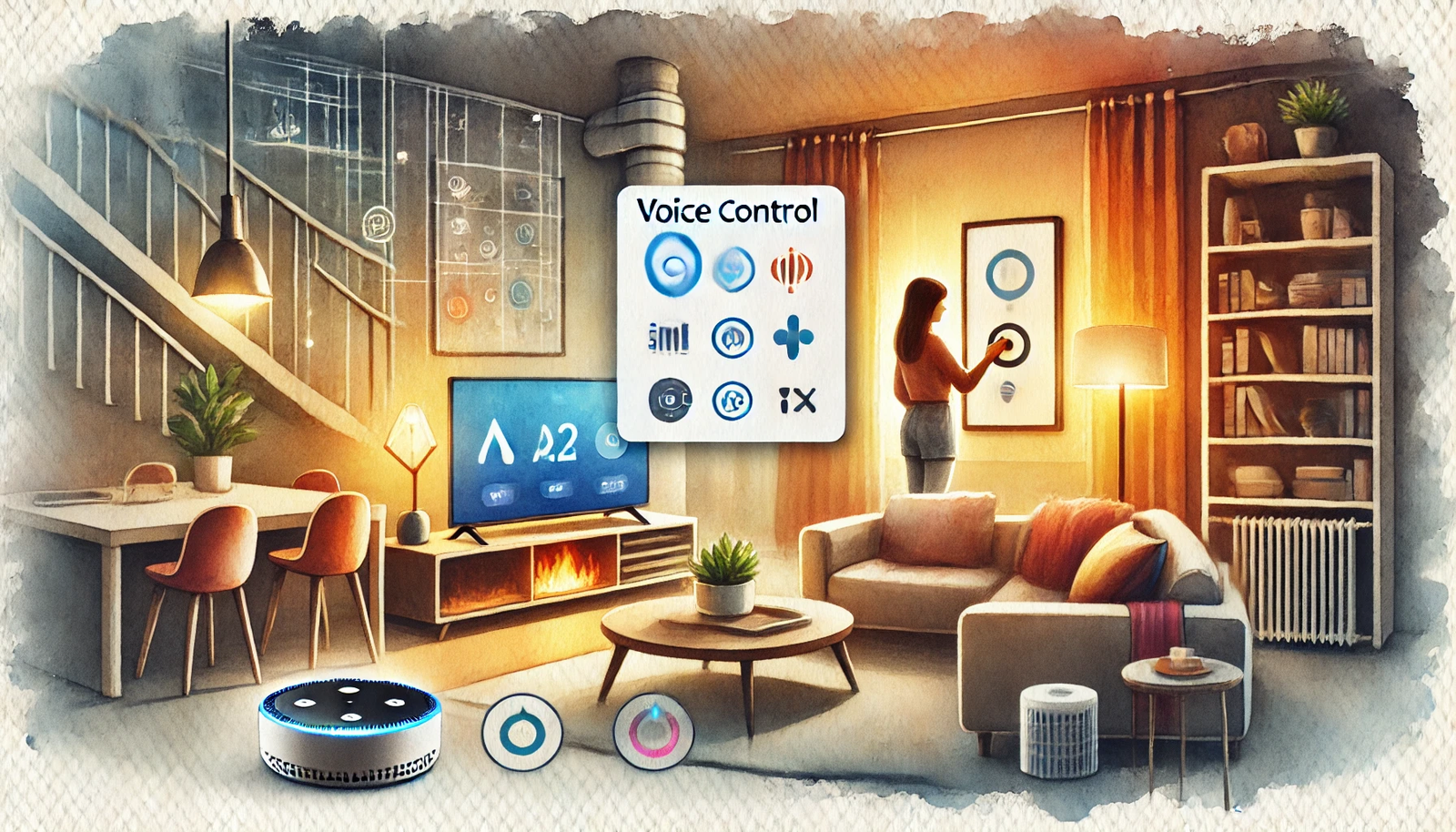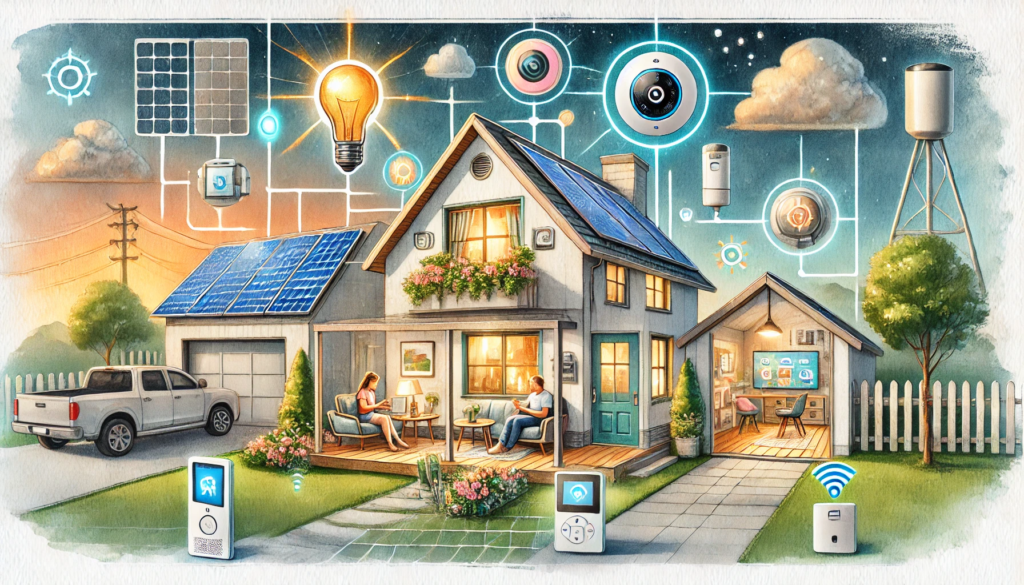
The way we live is evolving, and smart home technology is at the forefront of that change. From controlling your thermostat with a voice command to securing your home remotely, these innovations make everyday life more convenient, secure, and energy-efficient.
But with so many options available, upgrading your home can feel overwhelming. Where should you start? Which devices offer the most value? This guide will break it all down for you, offering 17 practical tips to help you enhance your home with smart technology.
Whether you’re looking to cut down on energy costs, boost security, or simply make life a little easier, these upgrades will transform your home into a modern, intelligent space. Let’s dive in.
1. Upgrade to a Smart Thermostat
A smart thermostat is one of the best investments you can make for a more efficient and comfortable home. Unlike traditional thermostats, which require manual adjustments, smart thermostats learn your habits and preferences to optimize heating and cooling automatically.
Key Benefits:
✅ Remote Control & Automation – Adjust your home’s temperature from anywhere using your smartphone. Forgot to turn down the heat before leaving? No problem—just change it from your app.
✅ Learning Schedules & Optimization – Many smart thermostats, like the Google Nest or Ecobee, use AI to analyze your routine and adjust the temperature accordingly. This ensures you stay comfortable while reducing unnecessary energy use.
✅ Cost Savings – By optimizing temperature settings, a smart thermostat can significantly reduce your heating and cooling bills, sometimes by as much as 10-20% annually.
2. Switch to Smart Lighting
Lighting plays a crucial role in setting the mood of your home, and smart lighting takes it to the next level. With smart bulbs and switches, you can control brightness, schedule lighting, and even change colors—all from your phone or voice assistant.
Key Benefits:
✅ Remote Control & Automation – Turn lights on or off from anywhere, whether you’re at home or on vacation. Set up motion-activated lighting for added convenience.
✅ Customizable Brightness & Colors – Adjust brightness to match different activities (like reading or watching movies) or choose from millions of colors for the perfect ambiance.
✅ Energy Efficiency – Smart LED bulbs use up to 75% less energy than traditional incandescent bulbs and last significantly longer. Scheduling lights to turn off when not needed also helps cut energy waste.
3. Install a Smart Security System

Home security is more advanced than ever, thanks to smart security systems. These systems integrate cameras, motion detectors, and alarms that you can monitor in real time—giving you peace of mind whether you’re home or away.
Key Benefits:
✅ Smart Cameras & Video Doorbells – Get live footage of your home, receive motion alerts, and even communicate with visitors through two-way audio. Popular options include Ring, Arlo, and Nest cameras.
✅ Real-Time Alerts & Remote Monitoring – If someone approaches your door or a window is opened, you’ll get an instant notification on your phone. Many systems can also alert emergency services automatically.
✅ Two-Way Communication for Added Security – Speak to delivery personnel or ward off potential intruders with built-in microphone and speaker functions on smart doorbells.
4. Use Smart Locks for Keyless Entry
Say goodbye to fumbling for keys or worrying about lost copies. Smart locks allow you to lock and unlock your doors remotely, granting access to trusted individuals without needing a physical key.
Key Benefits:
✅ Remote Locking & Unlocking – Lock or unlock your door from your smartphone, no matter where you are. This is especially useful if you forget to lock up when leaving the house.
✅ Digital Keys for Guests & Service Providers – Assign temporary or permanent digital access codes to family members, babysitters, or maintenance personnel. Many locks also allow you to track who enters and exits.
✅ Increased Security & Convenience – Smart locks can integrate with other security devices, like doorbell cameras, to enhance home protection. Some models even auto-lock when you leave.
5. Invest in Smart Plugs
Smart plugs are one of the easiest and most cost-effective ways to bring automation into your home. These small but powerful devices allow you to control regular appliances remotely, set schedules, and even monitor energy usage—all through your smartphone or voice assistant.
Key Benefits:
✅ Convert Regular Appliances into Smart Devices – Plug in lamps, coffee makers, fans, or even holiday lights to enable remote control and automation.
✅ Set Schedules & Monitor Energy Usage – Automate devices to turn on or off at specific times, helping to improve efficiency and reduce unnecessary power consumption. Many smart plugs also track energy usage, so you can identify high-energy appliances.
✅ Reduce Phantom Energy Consumption – Even when turned off, some appliances still draw power. Smart plugs eliminate this waste by cutting power completely when the device isn’t in use.
6. Choose a Smart Home Hub
A smart home hub acts as the central command center for your connected devices, ensuring they work together seamlessly. Whether you have smart locks, lights, thermostats, or speakers, a hub simplifies control by integrating everything into a single system.
Key Benefits:
✅ Centralized Control of Multiple Devices – Instead of managing each smart device separately, a hub lets you control everything from one interface.
✅ Integration with Alexa, Google Assistant, or Apple HomeKit – A smart hub allows voice assistants to communicate with various devices, making home automation effortless.
✅ Streamlined Automation Across Your Home – Set up routines that trigger multiple actions at once, like turning off all lights, locking doors, and adjusting the thermostat when you leave home.
Popular smart hubs include Amazon Echo, Google Nest Hub, and Samsung SmartThings.
7. Strengthen Your Wi-Fi Network
A strong and reliable Wi-Fi connection is the backbone of any smart home. The more smart devices you have, the more bandwidth you’ll need. Without a solid network, devices may lag, disconnect, or fail to function properly.
Key Benefits:
✅ Essential for Reliable Smart Home Performance – Smart locks, cameras, thermostats, and lights all rely on a stable connection. Weak Wi-Fi can lead to delays and interruptions.
✅ Upgrade Your Router or Use a Mesh Network – If your Wi-Fi signal doesn’t reach all areas of your home, consider a mesh network system (like Eero or Google Nest Wi-Fi) to eliminate dead zones and ensure smooth connectivity.
✅ Consider a Separate Network for IoT Devices – Keeping smart home devices on a dedicated guest or secondary network can enhance security and prevent overloading your main Wi-Fi.
8. Create Device Groups and Routines
One of the biggest advantages of smart home technology is automation. Instead of controlling devices individually, you can group them by room or function and create routines that trigger multiple actions with a single command.
Key Benefits:
✅ Grouping Devices by Room for Easy Control – Manage all smart lights, speakers, and appliances in a single room with one voice command or tap on your phone.
✅ Automate Multiple Tasks with a Single Command – Set up routines like “Good Morning” to turn on lights, adjust the thermostat, and start the coffee maker automatically.
✅ Improve Efficiency with Pre-Set Routines – Save time and energy by scheduling devices to turn on/off based on your daily habits. For example, automatically dim lights and lower the thermostat at bedtime.
9. Upgrade to a Smart TV

Entertainment has never been more accessible thanks to smart TVs, which integrate streaming services, voice control, and seamless connectivity with other smart devices.
Key Benefits:
✅ Integrated Streaming Services & App Control – Watch Netflix, Hulu, Disney+, and more without needing additional devices. Many smart TVs also let you install apps like YouTube, Spotify, and even home automation controls.
✅ Voice Commands for Hands-Free Operation – Control playback, search for content, or adjust volume using Alexa, Google Assistant, or Apple Siri.
✅ Enhanced Entertainment Experience – Some smart TVs include AI-powered picture enhancement, automatic brightness adjustment, and gaming mode optimizations for the best viewing experience.
10. Install Smart Smoke and Carbon Monoxide Detectors
Traditional smoke and carbon monoxide (CO) detectors are essential, but smart detectors take home safety to the next level. These devices send real-time alerts to your smartphone, ensuring you’re informed of potential dangers—even when you’re not home.
Key Benefits:
✅ Remote Alerts for Fire and Gas Leaks – Receive instant notifications on your phone if smoke or CO is detected, allowing for quick action.
✅ Increased Safety When Away from Home – If an alarm triggers while you’re out, you can contact emergency services or alert a neighbor immediately.
✅ Faster Response Time for Emergencies – Many smart detectors integrate with other devices, such as turning on smart lights to illuminate escape routes or automatically shutting off HVAC systems to prevent smoke from spreading.
Popular options include Google Nest Protect and First Alert Onelink.
11. Implement a Smart Irrigation System
A smart irrigation system ensures your garden or lawn stays healthy without wasting water. These systems adjust watering schedules based on weather conditions, soil moisture, and even seasonal changes.
Key Benefits:
✅ Automatic Adjustments Based on Weather Forecasts – Prevents overwatering by skipping scheduled watering on rainy days.
✅ Water Conservation and Optimized Lawn Care – Smart sprinklers detect soil conditions and deliver just the right amount of water.
✅ Reduced Utility Costs – Efficient watering means lower water bills and a more eco-friendly home.
Top systems include Rachio, Orbit B-hyve, and RainMachine.
12. Use Smart Window Coverings
Smart window coverings, such as motorized blinds or curtains, provide automated control for convenience, privacy, and energy efficiency. These can be scheduled or controlled via voice commands, smartphone apps, or even sensors.
Key Benefits:
✅ Remote and Scheduled Control of Blinds or Curtains – Open and close your window coverings from anywhere or set automated schedules.
✅ Helps with Temperature Regulation and Privacy – Keep your home cool in summer and warm in winter by adjusting blinds based on sunlight.
✅ Increases Energy Efficiency – Smart blinds help reduce heating and cooling costs by minimizing heat loss in winter and blocking excessive sunlight in summer.
Popular options include Lutron Serena, IKEA Fyrtur, and Somfy motorized blinds.
13. Invest in Energy Monitoring Systems
If you’re looking to cut down on energy waste and lower your utility bills, an energy monitoring system is a must. These systems provide real-time data on your home’s energy consumption and help identify power-hungry appliances.
Key Benefits:
✅ Track Home Energy Usage in Real Time – Get insights into how much power each device uses and when.
✅ Identify Areas for Reducing Waste – Find inefficient appliances or devices that consume energy even when idle.
✅ Lower Monthly Electricity Bills – Adjust habits and replace high-energy appliances to save money.
Smart energy monitors like Sense, Emporia Vue, and Neurio integrate with your smart home hub to provide alerts and recommendations.
14. Utilize Voice Control

Voice control transforms the way you interact with your smart home by providing hands-free operation of connected devices. Whether you want to dim the lights, adjust the thermostat, or lock the doors, a simple voice command can get the job done.
Key Benefits:
✅ Hands-Free Control of Smart Devices – No need to use an app or remote; just speak commands to control lights, thermostats, and security systems.
✅ Compatible with Alexa, Google Assistant, and Siri – Most smart home devices integrate with popular voice assistants for seamless operation.
✅ Enhanced Accessibility and Convenience – Voice control is especially helpful for individuals with mobility challenges or those who want a frictionless smart home experience.
Popular options include Amazon Echo (Alexa), Google Nest (Google Assistant), and Apple HomePod (Siri).
15. Secure Your Smart Home Network
A secure network is critical for protecting your smart home from cyber threats. Since connected devices are vulnerable to hacking, taking proactive security measures can prevent unauthorized access.
Key Benefits:
✅ Use Strong, Unique Passwords for All Devices – Avoid default passwords and use a password manager to create and store complex credentials.
✅ Regular Software Updates to Prevent Vulnerabilities – Keeping your devices and router firmware updated ensures they are protected against security risks.
✅ Set Up a Dedicated Network for IoT Devices – Isolating smart home devices on a separate network reduces the risk of cyber intrusions affecting your primary devices.
Additional security tips include enabling two-factor authentication (2FA), disabling unnecessary features (like remote access when not needed), and monitoring network activity for suspicious behavior.
16. Optimize Smart TV Privacy and Security
Smart TVs come with built-in streaming services and internet connectivity, but they also collect data and can be vulnerable to cyber threats. Optimizing privacy settings can protect your personal information and enhance security.
Key Benefits:
✅ Adjust Settings to Limit Data Collection – Disable tracking features that share viewing habits with advertisers.
✅ Use Secure Login Methods for Streaming Services – Enable two-factor authentication (2FA) for apps like Netflix, Hulu, and Disney+.
✅ Protect Personal Information from Cyber Threats – Avoid using public Wi-Fi, keep your smart TV firmware updated, and disable voice recognition if not needed.
Additional security measures include installing a firewall, using a VPN for streaming, and regularly reviewing privacy policies of installed apps.
17. Plan for Future Smart Home Upgrades
Smart home technology evolves rapidly, so keeping your setup up to date ensures optimal performance and compatibility. Regularly assessing your smart ecosystem helps you take advantage of new innovations while phasing out outdated devices.
Key Benefits:
✅ Regularly Assess and Expand Your Smart Ecosystem – Identify gaps in automation and areas where smart technology can improve convenience or efficiency.
✅ Stay Updated on New Technology and Trends – Follow smart home blogs, tech reviews, and manufacturer updates to discover cutting-edge solutions.
✅ Upgrade Outdated Devices for Better Performance – Older devices may lack support for the latest security updates or integrations—replacing them ensures smooth operation and enhanced security.
Future-proofing your smart home keeps it running efficiently and ensures long-term compatibility with emerging technologies.
Conclusion
Upgrading to a smart home doesn’t have to be overwhelming. By implementing even a few of these 17 smart home upgrades, you can enhance convenience, security, and energy efficiency in meaningful ways.
Recap of Key Upgrades:
✅ Start with Essentials – Smart thermostats, lighting, and security systems provide immediate benefits.
✅ Enhance Automation – Use smart plugs, hubs, and routines to simplify daily tasks.
✅ Prioritize Security – Strengthen your Wi-Fi network, secure devices with strong passwords, and protect smart TVs from data tracking.
✅ Optimize Energy Use – Smart irrigation, window coverings, and energy monitoring systems help cut costs.
✅ Plan for the Future – Stay updated on smart home trends and upgrade outdated devices when needed.
Start Small and Expand
You don’t need to transform your home overnight. Begin with one or two upgrades, such as installing a smart thermostat or switching to smart bulbs. As you get comfortable, expand your smart ecosystem with additional devices tailored to your needs.
Final Thoughts
A well-integrated smart home saves time, increases security, and improves energy efficiency—all while making daily life more convenient. By gradually adopting these upgrades, you’ll create a smarter, safer, and more efficient home that enhances your lifestyle and future-proofs your living space.
Ready to take the first step? Start with one simple upgrade today and watch your home transform! 🚀
Frequently Asked Questions (FAQs)
1. What is a smart home and how can it benefit me?
A smart home integrates connected devices—like thermostats, lights, and security systems—that work together to enhance convenience, security, and energy efficiency. It allows you to control your home remotely, automate routine tasks, and ultimately save time and money.
2. Where should I start with smart home upgrades?
Start with essential devices that offer immediate benefits, such as a smart thermostat for energy savings, smart lighting for ambiance and efficiency, and a smart security system for enhanced safety. Once you’re comfortable, expand your system with additional devices like smart plugs, hubs, and voice control.
3. Are smart home devices secure and how can I protect my network?
Smart home devices can be secure when set up correctly. Always use strong, unique passwords, keep firmware updated, and consider creating a dedicated network for your IoT devices. These steps help reduce vulnerabilities and protect your personal data.
4. How can smart home upgrades help reduce my energy bills?
Smart home devices optimize energy use by automating temperature adjustments, scheduling lights to turn off when not needed, and monitoring real-time energy consumption. Over time, these smart upgrades can lead to significant savings on your utility bills.
5. How do I plan for future smart home upgrades?
Regularly assess your current setup and stay informed about emerging technologies. Upgrading outdated devices and gradually expanding your smart ecosystem ensures your home remains efficient, secure, and compatible with the latest innovations.

